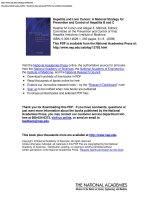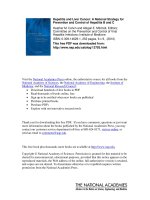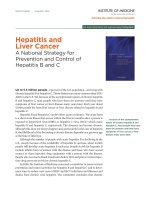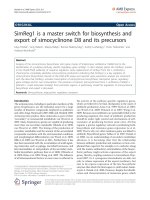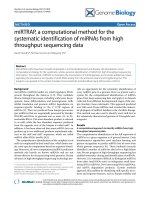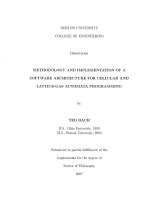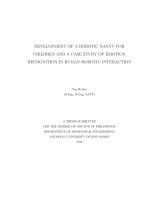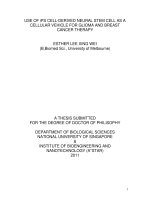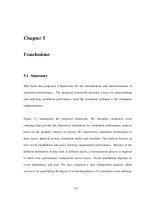a software pipeline for processing and identification of fungal its sequences
Bạn đang xem bản rút gọn của tài liệu. Xem và tải ngay bản đầy đủ của tài liệu tại đây (376.71 KB, 6 trang )
Source Code for Biology and
Medicine
BioMed Central
Open Access
Software review
A software pipeline for processing and identification of fungal ITS
sequences
R Henrik Nilsson*1, Gunilla Bok1, Martin Ryberg1, Erik Kristiansson2 and
Nils Hallenberg1
Address: 1University of Gothenburg, Department of Plant and Environmental Sciences, Box 461, 405 30 Göteborg, Sweden and 2The Sahlgrenska
Academy at the University of Gothenburg, Department of Neuroscience and Physiology, Box 434, 405 30 Göteborg, Sweden
Email: R Henrik Nilsson* - ; Gunilla Bok - ; Martin Ryberg - ;
Erik Kristiansson - ; Nils Hallenberg -
* Corresponding author
Published: 15 January 2009
Source Code for Biology and Medicine 2009, 4:1
doi:10.1186/1751-0473-4-1
Received: 12 November 2008
Accepted: 15 January 2009
This article is available from: />© 2009 Nilsson et al; licensee BioMed Central Ltd.
This is an Open Access article distributed under the terms of the Creative Commons Attribution License ( />which permits unrestricted use, distribution, and reproduction in any medium, provided the original work is properly cited.
Abstract
Background: Fungi from environmental samples are typically identified to species level through
DNA sequencing of the nuclear ribosomal internal transcribed spacer (ITS) region for use in
BLAST-based similarity searches in the International Nucleotide Sequence Databases. These
searches are time-consuming and regularly require a significant amount of manual intervention and
complementary analyses. We here present software – in the form of an identification pipeline for
large sets of fungal ITS sequences – developed to automate the BLAST process and several
additional analysis steps. The performance of the pipeline was evaluated on a dataset of 350 ITS
sequences from fungi growing as epiphytes on building material.
Results: The pipeline was written in Perl and uses a local installation of NCBI-BLAST for the
similarity searches of the query sequences. The variable subregion ITS2 of the ITS region is
extracted from the sequences and used for additional searches of higher sensitivity. Multiple
alignments of each query sequence and its closest matches are computed, and query sequences
sharing at least 50% of their best matches are clustered to facilitate the evaluation of hypothetically
conspecific groups. The pipeline proved to speed up the processing, as well as enhance the
resolution, of the evaluation dataset considerably, and the fungi were found to belong chiefly to the
Ascomycota, with Penicillium and Aspergillus as the two most common genera. The ITS2 was found to
indicate a different taxonomic affiliation than did the complete ITS region for 10% of the query
sequences, though this figure is likely to vary with the taxonomic scope of the query sequences.
Conclusion: The present software readily assigns large sets of fungal query sequences to their
respective best matches in the international sequence databases and places them in a larger
biological context. The output is highly structured to be easy to process, although it still needs to
be inspected and possibly corrected for the impact of the incomplete and sometimes erroneously
annotated fungal entries in these databases. The open source pipeline is available for UNIX-type
platforms, and updated releases of the target database are made available biweekly. The pipeline is
easily modified to operate on other molecular regions and organism groups.
Page 1 of 6
(page number not for citation purposes)
Source Code for Biology and Medicine 2009, 4:1
Background
The fungal kingdom is thought to comprise upwards of
1.5 million species, a figure that contrasts sharply with the
97,000 species of fungi described so far [1,2]. The discrepancy between the estimated and the known fungal diversity is largely ascribable to the non-conspicuous nature of
fungal life; most species are readily visible, and thus amenable for collection, only when they form fruiting-bodies
or other propagation structures [3,4]. Yet fungi are ubiquitously present in all biota as mycelia or other, non-hyphal
life stages, and studies have revealed that fungi may
account for as much as 90% of the living biomass of some
ecosystems [5]. The important ecological roles played by
fungi in terms of nutrient recycling, symbiosis, and parasitism call for a deeper, taxonomy-oriented understanding
of the mycoflora of the world, and one far more detailed
than any fruiting-body based field inventory could ever
bring about [6,7]. Mycologists of today thus face the
daunting task of locating and identifying large sets of
fungi from non-trivial substrates such as soil, decaying
wood, and plant debris, often in the complete absence of
any physical manifestation of the fungi present.
The last ten years have seen a surge in the use of DNA
sequences as a means to seek to identify fungi from various substrates and in different life stages to species level
[8,9]. The most frequently sequenced region for such purposes is the internal transcribed spacer (ITS) region of the
nuclear ribosomal DNA [10]. Though it does not come
without complications [11], this ~550 base-pair (bp),
transcribed but non-coding region is present in upwards
of 250 copies per cell [12], which makes it relatively
straightforward to amplify even from scanty input material. The high level of variability in two of its three subregions (ITS1 and ITS2) coupled with the very low
variability of the intercalary third subregion (5.8S) make
the region an advantageous choice for assignment of a
query sequence to species level or a higher fungal taxon
[13,14]. Such inferences are typically achieved through
similarity searches using BLAST [15] against the International Nucleotide Sequence Databases (INSD: GenBank,
EMBL, DDBJ; [16]).
While BLAST is a powerful and versatile software package,
its use over the web is dependent on server load and web
traffic intensity. To compile and interpret its output in the
case of multiple query sequences tends to be time-consuming and involve a significant amount of manual intervention. It is furthermore often necessary to re-run a
certain proportion of the query sequences after the
removal of overly conserved sequence segments – here the
nuclear small subunit (nSSU/16S/18S), the 5.8S, and the
nuclear large subunit (nLSU/25S/28S) – in order to obtain
fine-grained detail [13,17-19]. It may even be necessary to
compile a multiple alignment of certain query sequences
/>
and their respective best matches and analyse the alignment under more powerful optimality criteria than similarity – such as phylogenetic analysis – in order to obtain
sufficient resolution [cf. [20-23]]. To process an authentic
set of fungal sequences obtained through environmental
sampling thus often proves a lengthy and laborious process. The present study attempts a remedy in the form of a
Perl-based software pipeline for rapid BLAST processing of
large sets (10–100,000 s) of fungal query sequences. The
pipeline streamlines functions such as automated ITS2based BLAST runs for finer precision, the computation of
multiple alignments for subsequent use, and the generation of comprehensible and easily analysed summaries of
the results. The pipeline is designed to work in any UNIXtype environment (including MacOS X, Linux, and BSD)
for which NCBI-BLAST, HMMER [24], and one or more of
Clustal W [25], DIALIGN-TX [26], and MAFFT [27] are
available.
To evaluate the performance of the pipeline on a large,
authentic dataset, 350 ITS sequences were obtained from
fungi growing on buildings in Sweden. Fungal growth on
building material causes significant economic loss and is
frequently connected to the Sick Building Syndrome [28].
The present sampling was carried out as a part of a larger
study to characterize such fungal communities; detailed
knowledge of the taxonomic affiliations of these fungi is
likely to form a key element in assessing health risks
caused by mass occurrence of fungi in moist damaged
buildings [29].
Implementation and methods
The pipeline [Additional file 1] was written in Perl 5 [30]
and acts as a wrapper for NCBI-BLAST, HMMER, and
Clustal W/DIALIGN-TX/MAFFT. By default, all fungal ITS
sequences annotated as such in INSD are used as target
database (approximately 110,000 sequences as of December 2008). Optionally, the user may choose to include
only sequences identified to species level in the database.
Tailored, biweekly updated versions of these databases are
made available by the authors at [31].
For each query sequence, blastn of the NCBI-BLAST package is run locally, and the result is parsed to retrieve the 15
(default; adjustable) best (topmost) matches in INSD. An
attempt is then made to locate and extract the ITS2 from
the same query sequence using HMMER and the Markov
models employed by Nilsson et al [14]. If successful, the
ITS2 of the query sequence is used as the query in a new
BLAST run against the same database, again with the 15
(default) best matches saved. The fifteen best matches of
the first BLAST run are aligned jointly with the query
sequence using Clustal W (default), DIALIGN-TX, or
MAFFT to present the sequences in a more integrative context than the pairwise alignments of the BLAST output.
Page 2 of 6
(page number not for citation purposes)
Source Code for Biology and Medicine 2009, 4:1
The default value of the number of sequences to retain in
the above steps was set to 15 as a product of the present
focus on very similar sequences and the computational
capacity at hand.
Upon completion of the BLAST runs, all query sequences
that share at least 50% (default; adjustable) of their 15
best BLAST matches are clustered and aligned accordingly.
Conspecific and closely related sequences are likely to be
grouped into clusters in this step. Similarly, all sequences
not a member of any such group are listed – in all likelihood, these singleton sequences represent species present
only once among the query sequences. Ample screen output is given for each of the query sequences, and the
results are summarized in a joint tab-separated file for
viewing in any spreadsheet-type program (e.g., Open
Office or Excel). The pipeline is released under the GNUGPL software license version 2 and makes use of only
freely available software. Although distributed over the
web, the pipeline does not require an Internet connection
to run.
The fungi were isolated from different kinds of building
materials, e.g. wood, fibreboard, and linoleum mat, with
varying extent of mould growth on the surface. The surface of the sample was scraped with a sterile needle and
the scraped product was mixed with distilled water. The
suspension was spread out on Petri dishes (Ø 9 cm) containing 2% malt extract agar (MEA) or dichloran 18% –
glycerol agar (DG18). The samples were incubated in daylight at room temperature (20°C). Subsequently, fungal
colonies were sub-cultured to new Petri dishes (Ø 6 cm)
as part of the cleaning process. A total of 350 sequences
were extracted using DNeasy Plant Mini Kit (QIAGEN,
Hilden); amplified using READY-TO-GO PCR beads
(QIAGEN) and the ITS1F and ITS4 primers; purified using
the QiaQuick Spin Procedure Kit (QIAGEN); and
sequenced using the ITS1F and ITS4 primers and the CEQ
2000XL DNA Analysis System (Beckman Coulter, Fullerton). Full details of the laboratory procedures are available in [32]. The sequences were pooled and fed to the
pipeline using its default settings. Decisions of taxonomic
affiliations were done considering the results from both
the full ITS region and from the ITS2 region, including
studying the alignments in non-trivial cases, with priority
given to the ITS2 data where the results differed.
Results and discussion
The 350 query sequences from mould growth on building
material were found to be distributed among 42 distinct
groups, each composed of mutually similar sequences to
the exclusion of the other groups, and 27 singletons that
did not match any other query sequence closely. The absolute majority (98%) of the fungal species recovered were
found to belong to the Ascomycota, with a modest 2% of
/>
the sequences belonging to the Zygomycota (Fig. 1; Additional file 2). The two most common genera, Penicillium
and Aspergillus, were totally dominant among the
sequences with an occurrence of 58% and 16%, respectively. The most frequently occurring Penicillium species
were P. chrysogenum, P. corylophilum, P. glabrum, and P.
commune. The three latter species have as a rule not been
identified to species level – but rather only to genus level
– in prior biodiversity studies of building material due to
the considerable difficulties in telling them apart using
morphological analysis [33,34], a shortcoming that
molecular data and the present software package are set to
address. Aspergillus versicolor, A. niger, and A. ustus were the
three most common species of the genus Aspergillus,
which again represents a finer view than that presented in
many surveys based on traditional techniques. Indeed, the
view of the building mycoflora as revealed by the software
pipeline shares many overall similarities with those from
similar studies [35] but stands out through the level of resolution obtained on the species level [36,37]. The taxonomic and nomenclatural issues surrounding Penicillium
and Aspergillus are far from trivial, however, and the lack
of inclusive modern revisions and well-identified reference sequences are likely to have influenced the results of
the present and many other efforts.
The evaluation dataset took two hours to run on a singlecore 2.3 GHz Pentium 4 workstation. This is a considerable improvement in speed over any attempt at performing
the corresponding BLAST runs over the web at INSD – particularly if complementary analyses have to be performed
for some subset of the query sequences – and additional
speed gains are to be attained if the pipeline is run on
multiple-core processors. Manual inspection of the results
revealed that the function to extract, and base the BLAST
run on, the ITS2 gave a different taxonomic result than did
the complete ITS region for about 10% of the cases (Additional file 2). This observation highlights the usefulness of
excluding the very conserved genes encoding for the ribosomal small subunit, 5.8S, and large subunit, particularly
when sequences from species not present in the target
database are used as query. The magnitude of the discrepancy between the taxonomic signal obtained from the
ITS2 and from the entire ITS region (including any portions of the flanking genes) can be expected to vary among
different groups of fungi.
The largest shortcoming of the present pipeline, as indeed
with all sequence-based identification procedures, is the
wanting state of taxonomic coverage and reliability in the
public sequence databases. These vary among different
taxonomic groups but form a tangible problem for the
fungal entries. A mere 13,300 (14%) of the 97,000
described species of fungi are represented by at least one
fully identified ITS sequence in INSD, a number that, in
Page 3 of 6
(page number not for citation purposes)
Source Code for Biology and Medicine 2009, 4:1
/>
Figure 1 distribution of the species recovered from the substrates
Taxonomic
Taxonomic distribution of the species recovered from the substrates. The taxonomic distribution of the species in
the pooled evaluation dataset over (A) the two fungal phyla retrieved, (B) the most common genera retrieved, (C) the most
common species of Penicillium, and (D) the most common species of Aspergillus. The sequences were found to belong to 28 different fungal genera and 49 distinct species; an additional 11 sequences could not be assigned to species level with confidence
due to the lack of fully identified reference sequences.
turn, pales in comparison with the estimated 1.5 million
extant species of fungi. More than 10% of the fungal INSD
sequences under study have, furthermore, been shown to
be incorrectly identified to species level [38,39]. Adding to
the complexity, 39% of the fungal ITS sequences in INSD
are not identified to species level in the first place, and
their sheer number often serves to mask the presence of
explanatory, fully identified sequences in the BLAST hit
list [40-42]. This is, however, a problem to which the
present study offers a partial remedy in the form of the
option to use only fully identified sequences in the BLAST
reference database.
in-depth analyses. As with BLAST itself, however, the pipeline should be used on the understanding that definite
assignment of a query sequence to species level is not
amenable to algorithmic interpretation other than in a
trivial sense, and in consideration of the fact that additional analysis steps may be needed, particularly for problematic query sequences.
Availability and requirements
Project name: FungalITSPipeline
Project home page: />spipeline.html
Conclusion
We see the presented pipeline as a way to speed up the
processing of large numbers of query sequences and to
obtain extended functionality helpful for complementary,
Operating systems: UNIX-type (MacOS X, Linux, UNIX/
BSD)
Page 4 of 6
(page number not for citation purposes)
Source Code for Biology and Medicine 2009, 4:1
Programming language: Perl
Other requirements: NCBI-BLAST, HMMER, optionally
at least one of Clustal W, DIALIGN-TX, and MAFFT
Licence: GNU GPL 2
Any restrictions to use by non-academics: None other
than those imposed by GNU GPL 2
Notes: The pipeline is available at the above address
together with its documentation, the evaluation dataset,
and biweekly updated BLAST database files. All these files
are also bundled as additional data files with this manuscript. The pipeline is straightforward to adapt for other
DNA regions and organism groups; new BLAST databases
need to be assembled and the ITS2 mode should be
turned off (or HMMs for the new gene need to be constructed).
/>
work. Five anonymous referees are acknowledged for valuable input on the
manuscript and software. Only freely available software was used in the
making of this study.
References
1.
2.
3.
4.
5.
6.
7.
8.
Competing interests
The authors declare that they have no competing interests.
Authors' contributions
RHN wrote the chief part of the pipeline, to which MR and
EK contributed with subroutines and suggestions. GB and
NH undertook the sampling and DNA sequencing of the
fungi of the evaluation dataset and were responsible for
the study design. All authors contributed to the manuscript and approved its final version.
Additional material
9.
10.
11.
12.
13.
Additional file 1
The software pipeline. The software pipeline described in the paper,
together with its documentation, installation instructions, and the seed of
a BLAST database.
Click here for file
[ />
14.
15.
Additional file 2
The evaluation dataset. The evaluation dataset (in the FASTA format)
and the results of its analysis (a summary in the OpenOffice/Excel spreadsheet format with multiple alignments in the ALN (Clustal W) format
and a list of the species recovered in the PDF format).
Click here for file
[ />
16.
17.
18.
19.
Acknowledgements
Financial support from FORMAS to NH and GB, and from Kapten Carl
Stenholms Donationsfond to RHN and MR is gratefully acknowledged. Figure 1 was designed in collaboration with Bomb Mediaproduktion. RHN
acknowledges infrastructure support from the Fungi in Boreal Forests net-
20.
21.
Hawksworth DL: The magnitude of fungal diversity: the 1.5
million species estimate revisited.
Mycol Res 2001,
105:1422-1432.
Kirk PM, Cannon PF, Minter DW, Stalpers JA: Dictionary of the Fungi
10th edition. Wallingford: CABI Publishing; 2008.
Horton TR, Bruns TD: The molecular revolution in ectomycorrhizal ecology: peeking in the black-box. Mol Ecol 2001,
10:1855-1871.
Hibbett DS: After the gold rush, or before the flood? Evolutionary morphology of mushroom-forming fungi (AgaricoMycol Res 2007,
mycetes) in the early 21st century.
111:1001-1018.
Moore D, Novak LA: Essential Fungal Genetics New York: SpringerVerlag; 2002.
Blackwell M, Hibbett DS, Taylor JW, Spatafora JW: Research coordination networks: a phylogeny for kingdom Fungi (Deep
Hypha). Mycologia 2006, 98:829-837.
Taylor DL, McCormick MK: Internal transcribed spacer primers
and sequences for improved characterization of basidiomycetous orchid mycorrhizas. New Phytol 2008, 177:1020-1033.
Kõljalg U, Larsson K-H, Abarenkov K, Nilsson RH, Alexander IJ, Eberhardt U, Erland S, Høiland K, Kjøller R, Larsson E, Pennanen T, Sen R,
Taylor AFS, Tedersoo L, Vrålstad T, Ursing BM: UNITE: a database
providing web-based methods for the molecular identification of ectomycorrhizal fungi. New Phytol 2005, 166:1063-1068.
Seifert KA, Samson RA, deWaard JR, Houbraken J, Levesque CA,
Molcalvo J-M, Louis-Seize G, Hebert PDN: Prospects for fungus
identification using CO1 DNA barcodes, with Penicillium as a
test case. Proc Natl Acad Sci USA 2007, 104:3901-3906.
Hibbett DS, Nilsson RH, Snyder M, Fonseca M, Costanzo J, Shonfeld
M: Automated phylogenetic taxonomy: an example in the
homobasidiomycetes (mushroom-forming fungi). Syst Biol
2005, 54:660-668.
Avis PG, Dickie IA, Mueller GM: A 'dirty' business: testing the
limitations of terminal restriction fragment length polymorphism (TRFLP) analysis of soil fungi. Mol Ecol 2006, 15:873-882.
Vilgalys R, Gonzalez D: Organization of ribosomal DNA in the
basidiomycete Thanathephorus praticola. Curr Genet 1990,
18:277-280.
Bruns TD, Shefferson RP: Evolutionary studies of ectomycorrhizal fungi: recent advances and future directions. Can J Bot
2004, 82:1122-1132.
Nilsson RH, Kristiansson E, Ryberg M, Hallenberg N, Larsson K-H:
Intraspecific ITS variability in the kingdom Fungi as
expressed in the international sequence databases and its
implications for molecular species identification. Evol Bioinform Online 2008, 4:193-201 [ />Altschul SF, Madden TL, Schaffer AA, Zhang J, Zhang Z, Miller W, Lipman DJ: Gapped BLAST and PSI-BLAST: a new generation of
protein database search programs. Nucleic Acids Res 1997,
25:3389-3402.
Benson DA, Karsch-Mizrachi I, Lipman DJ, Ostell J, Wheeler DL:
GenBank. Nucleic Acids Res 2008, 35:D25-D30.
Leaw SN, Chang HC, Sun HF, Barton R, Bouchara J-P, Chang TC:
Identification of medically important yeast species by
sequence analysis of the internal transcribed spacer regions.
J Clin Microbiol 2006, 44:693-699.
Hau J, Muller M, Pagni M: HitKeeper, a generic software package for hit list management. Source Code Biol Med 2007, 2:2.
Gollapudi R, Revanna KV, Hemmerich C, Schaack S, Dong Q: BOV –
a web-based BLAST output visualization tool. BMC Genomics
2008, 9:414.
Nilsson RH, Larsson K-H, Ursing BM: galaxie – CGI scripts for
sequence identification through automated phylogenetic
analysis. Bioinformatics 2004, 20:1447-1452.
Nilsson RH, Rajashekar B, Larsson KH, Ursing BM: galaxieEST:
addressing EST identity through automated phylogenetic
analysis. BMC Bioinformatics 2004, 5:87.
Page 5 of 6
(page number not for citation purposes)
Source Code for Biology and Medicine 2009, 4:1
22.
23.
24.
25.
26.
27.
28.
29.
30.
31.
32.
33.
34.
35.
36.
37.
38.
39.
40.
41.
42.
Giancarlo R, Siragusa A, Siragusa E, Utro F: A basic analysis toolkit
for biological sequences. Algorithms Mol Biol 2007, 2:10.
Hanekamp K, Bohnebeck U, Beszteri B, Valentin K: PhyloGena – a
user-friendly system for automated phylogenetic annotation
of unknown sequences. Bioinformatics 2007, 23:793-801.
Eddy SR: Profile hidden Markov models. Bioinformatics 1998,
14:755-763.
Thompson JD, Gibson TJ, Plewniak F, Jeanmougin F, Higgins DG: The
CLUSTAL_X windows interface: flexible strategies for multiple sequence alignment aided by quality analysis tools.
Nucleic Acids Res 1997, 25:4876-4882.
Subramanian AR, Kaufmann M, Morgenstern B: DIALIGN-TX:
greedy and progressive approaches for segment-based multiple sequence alignment. Algorithms Mol Biol 2008, 3:6.
Katoh K, Kuma K, Toh H, Miyata T: MAFFT version 5: improvement in accuracy of multiple sequence alignment. Nucleic
Acids Res 2005, 33:511-518.
Skorge TD, Eagan TML, Eide GE, Gulsvik A, Bakke S: Indoor exposures and respiratory symptoms in a Norwegian community
sample. Thorax 2005, 60:937-942.
Flannigan B: Air sampling for fungi in indoor environments. J
Aerosol Sci 1997, 28:381-392.
Wall L, Christiansen T, Orwant J: Programming Perl 3rd edition. Sebastopol: O'Reilly Media; 2000.
The Fungal ITS Pipeline
[ />spipeline.html]
Paulus B, Nilsson RH, Hallenberg N: Phylogenetic studies in
Hypochnicium (Basidiomycota), with special emphasis on species from New Zealand. New Zeal J Bot 2007, 45:139-150.
Beguin H, Nolard N: Mould biodiversity in homes I. Air and surface analysis of 130 dwellings. Aerobiologia 1994, 10:157-166.
Hyvärinen A, Reponen T, Husman T, Ruuskanen J, Nevalainen A:
Compostion of fungal flora in mold problem houses determined with four different methods. In Proceedings of the 6th International Conference on Indoor Air Quality and Climate (Particles, microbes,
radon): 4–8 July 1993; Helsinki Volume 4. Edited by: Kalliokoski P, Jantunen M, Seppänen O. University of Technology; 1993:273-278.
Pietarinen VM, Rintala H, Hyvärainen H, Lignell U, Karkkainen P,
Nevalainen A: Quantitative PCR analysis of fungi and bacteria
in building materials and comparison to culture-based analysis. J Environ Monit 2008, 10:655-663.
Gravesen S, Nielsen PA, Iversen R, Nielsen KF: Microfungal contamination of damp buildings – examples of risk constructions and risk materials.
Environ Health Perspect 1999,
107:505-508.
Hyvärinen A, Meklin T, Vepsäläinen A, Nevalainen A: Fungi and
actinobacteria in moisture-damaged building materials –
concentrations and diversity. Int Biodeterior Biodegrad 2002,
49:27-37.
Bridge PD, Roberts PJ, Spooner BM, Panchal G: On the unreliability of published DNA sequences. New Phytol 2003, 160:43-48.
Nilsson RH, Ryberg M, Kristiansson E, Abarenkov K, Larsson K-H,
Kõljalg U: Taxonomic reliability of DNA sequences in public
sequences databases: a fungal perspective. PLoS ONE 2006,
1:e59.
Nilsson RH, Kristiansson E, Ryberg M, Larsson KH: Approaching
the taxonomic affiliation of unidentified sequences in public
databases – an example from the mycorrhizal fungi. BMC Bioinformatics 2005, 6:178.
Ryberg M, Nilsson RH, Kristiansson E, Jacobsson S, Larsson E: Mining
metadata from unidentified ITS sequences in GenBank: a
case study in Inocybe (Basidiomycota). BMC Evol Biol 2008, 8:50.
Ryberg M, Kristiansson E, Sjökvist E, Nilsson RH: An outlook on
the fungal ITS sequences in GenBank and the introduction of
a web-based tool for the exploration of fungal diversity. New
Phytol 2009, 181:471-477.
/>
Publish with Bio Med Central and every
scientist can read your work free of charge
"BioMed Central will be the most significant development for
disseminating the results of biomedical researc h in our lifetime."
Sir Paul Nurse, Cancer Research UK
Your research papers will be:
available free of charge to the entire biomedical community
peer reviewed and published immediately upon acceptance
cited in PubMed and archived on PubMed Central
yours — you keep the copyright
BioMedcentral
Submit your manuscript here:
/>
Page 6 of 6
(page number not for citation purposes)
